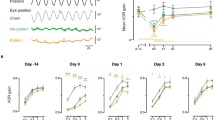Summary
Visual-vestibular interaction in the control of eye movement was investigated in six subjects during exposure to a low frequency (0.05 Hz) angular oscillation about the longitudinal axis of the body at four levels of peak head velocity: 30, 60, 90 and 120°/s. Eye movements were recorded whilst the subject was presented with a head-fixed visual display consisting of either a single central target or a pair of targets placed at ±20° in the periphery. For the lower stimulus levels (30 and 60°/s) the degree of suppression was reasonably constant and the vestibular nystagmus was never completely suppressed. However, during oscillation at higher velocity levels (90 and 120°/s) the relationship between eye velocity and head velocity became non-linear, the degree of suppression being much less during the high velocity periods of the waveform than when the head velocity was low. The changes in suppression may be interpreted as a decrease in gain of visual feedback as a function of increasing image velocity error on the retina.
Similar content being viewed by others
References
Abadi RV, Carden D, Simpson J (1981) Listening for eye movements. Ophthalmol Physiol Opt 1: 19–27
Barnes GR (1980) Vestibular control of oculomotor and postural mechanisms. Clin Phys Physiol Meas 1: 3–40
Barnes GR (1982a) A procedure for the analysis of nystagmus and other eye movements. Aviat Space Environ Med 53: 676–682
Barnes GR (1982b) The effects of retinal location and strobe rate of head-fixed visual targets on suppression of vestibular nystagmus. In: Roucoux A, Crommelinck M (eds) Physiological and pathological aspects of eye movements. Junk, The Hague, pp 281–300
Barnes GR (1983) The effects of retinal location on suppression of the vestibulo-ocular reflex. Exp Brain Res 49: 257–268
Barnes GR, Edge A (1983) The effects of strobe rate of head-fixed visual targets on suppression of vestibular nystagmus. Exp Brain Res 50: 228–236
Barnes GR, Benson AJ, Prior ARJ (1978) Visual-vestibular interaction in the control of eye movement. Aviat Space Environ Med 49: 557–564
Barr CC, Schultheis LW, Robinson DA (1976) Voluntary, nonvisual control of the human vestibulo-ocular reflex. Acta Otolaryngol (Stockh) 81: 365–375
Benson AJ, Barnes GR (1978) Vision during angular oscillation: the dynamic interaction of visual and vestibular mechanisms. Aviat Space Environ Med 49: 340–345
Büttner L, Meienberg O, Schimmelpfenning B (1982) The role of the fovea and parafoveal regions in the control of “fast” optokinetic response in the monkey. In: Roucoux A, Crommelinck M (eds) Physiological and pathological aspects of eye movements. Junk, The Hague, pp 173–179
Cohen B, Matsuo V, Raphan T (1977) Quantitative analysis of the velocity characteristics of optokinetic nystagmus and optokinetic after-nystagmus. J Physiol (Lond) 270: 321–344
Dichgans J (1977) Optokinetic nystagmus as dependent on the retinal periphery via the vestibular nucleus. In: Baker R, Berthoz A (eds) Control of gaze by brain stem neurons. Developments in neuroscience, vol 1. North Holland, Elsevier, Amsterdam, pp 261–267
Dubois MFW, Collewijn H (1979) Optokinetic reactions in man elicited by localized retinal motion stimuli. Vision Res 19: 1105–1115
Gilson RD, Guedry FE, Benson AJ (1970) Influence of vestibular stimulation and display luminance on the performance of a compensatory tracking task. Aerospace Med 41: 1231–1237
Grüsser OJ, Grüsser-Cornehls U (1973) Neuronal mechanisms of visual movement perception and some psychophysical and behavioural correlations. In: Jung R (ed) Central visual information (A). Handbook of sensory physiology vol VII/3. Springer, Berlin, Heidelberg, New York pp 333–429
Guedry FE (1968) Relations between vestibular nystagmus and visual performance. Aerospace Med 39: 570–579
Hyden D, Istl YE, Schwarz FWF (1982) Human visuo-vestibular interaction as a basis for quantitative clinical diagnostics. Acta Otolaryngol 94: 53–60
Koenig E, Allum JHH, Dichgans J (1978) Visual-vestibular interaction upon nystagmus slow-phase velocity in man. Acta Otolaryngol 85: 397–410
Koerner F, Schiller P (1972) The optokinetic response under open and closed loop conditions in the monkey. Exp Brain Res 14: 318–330
Oyster CW, Takahashi E, Collewijn H (1972) Direction-selective retinal ganglion cells and control of optokinetic nystagmus in the rabbit. Vision Res 12: 183–193
Raphan R, Cohen B, Matsuo V (1977) A velocity-storage mechanism responsible for optokinetic nystagmus (OKN), optokinetic after-nystagmus (OKAN) and vestibular nystagmus. In: Baker R, Berthoz A (eds) Control of gaze by brain stem neurons. Developments in neuroscience, vol 1 North Holland/ Elsevier, Amsterdam New York, pp 37–47
Schmid R, Buizza A, Zambarbieri D (1980) A non-linear model for visual-vestibular interaction during body rotation in man. Biol Cybern 36: 43–151
Waespe W, Büttner U, Henn V (1981) Input-output activity of the primate flocculus during visual-vestibular interaction. In: Cohen B (ed) Vestibular and oculomotor physiology. Ann NY Acad Sci 374: 491–503
Author information
Authors and Affiliations
Rights and permissions
About this article
Cite this article
Barnes, G.R., Edge, A. Non-linear effects in visual suppression of vestibular nystagmus. Exp Brain Res 52, 9–19 (1983). https://doi.org/10.1007/BF00237143
Received:
Issue Date:
DOI: https://doi.org/10.1007/BF00237143




